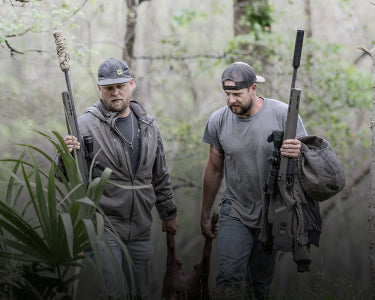Whether you’re hunting whitetail, mule, or axis, tracking a deer of any kind is a long but rewarding process. A hunter will need more than just marksmanship skills to spot and stalk America’s favorite large prey animal. Using patience, your keen powers of observation, and the list of helpful tips below, you just might be able to bring home that prize buck.
Read the Terrain
Understanding the lay of the land can significantly increase your chances of success. Look for key features like ridges, saddles, and funnels, which are natural travel corridors for deer. Consider the direction of the wind and how it affects scent dispersion. Evaluate the available food sources and water, as these attract deer. By carefully studying the terrain, you can predict where deer are likely to be and position yourself accordingly. Remember, patience and observation are key to mastering this skill.
Know the Weather Forecast Before You Hunt
The weather forecast can dramatically influence your success. For instance, a cold front's approach can dramatically alter deer behavior. As frigid air nears, deer will often engage in a feeding frenzy, stocking up on calories to combat the impending cold snap. These animals are highly attuned to their environment and instinctively prepare for changing conditions. By recognizing these patterns, hunters can strategically position themselves in areas rich with food sources, increasing their chances of encountering a hungry deer.
Beyond cold fronts, other weather conditions like wind, rain, and temperature fluctuations also impact deer activity. A keen eye on the forecast allows hunters to adapt their strategies accordingly.
Read Deer Sign
Fresh tracks and droppings can reveal a wealth of information about deer movement and behavior. By carefully examining these clues, you can pinpoint high-traffic areas and potential bedding locations.
Don't underestimate the value of nearby sign. Often, the best hunting spot is closer than you think. If you discover fresh tracks and feeding signs near your vehicle, it's a strong indicator that deer are actively using the area. Consider the food source they've been utilizing and where they might be headed next, typically a secluded bedding area.
Deer tracks provide valuable insights. The size and shape of tracks can offer clues about the deer's age and sex. Look for patterns in the tracks to determine travel direction and frequency. Scat can also be informative, as its appearance and location can help estimate deer numbers and recent activity in an area.
Deer Tracks

- Identify the track: Deer tracks have a distinctive heart shape, formed by the two hoofed toes.
- Determine direction: The point of the heart always points in the direction the deer was traveling.
- Assess size: Larger tracks generally indicate a larger deer, such as a mature buck.
- Observe the pattern: Look for the sequence of tracks left by all four feet. This can reveal gait and speed.
- Walking: Tracks are close together, with hind tracks nearly overlapping front tracks.
- Trotting: Tracks are more spaced out, with clear separation between front and hind feet.
- Running: Tracks are widely spaced, often with long strides.
Deer Scat

- Examine the shape: Deer scat is typically small, pellet-shaped, and has a pointed tip.
- Assess size and color: The size and color can vary depending on diet.
- Consider location: Scat found in clusters often indicates a bedding area.
- Check for freshness: Fresh scat is darker and softer than older scat.
- Remember: Practice is key to becoming proficient at reading deer tracks and scat. The more time you spend observing, the better you'll become at interpreting these signs.
Rubs

These marks, created when bucks scrape their antlers against trees, provide valuable insights into deer activity. By carefully examining rubs, you can determine a buck's age, recent activity, and potential travel routes.
Look for trees with stripped bark, often on saplings or young hardwoods. The size of the rub can indicate the buck's antler size. Fresh rubs will have bright, fresh-looking bark. As time passes, the bark will darken and become weathered. Deer prefer trees with aromatic bark, like cedar and pine, as these species leave behind scent when rubbed. To gauge the age of a rub, you can experiment by scratching similar trees with a knife and observing how the marks change over time.
Another key indicator of a rub's freshness is the condition of the bark shavings at the base of the tree. A neat pile suggests a recent rub, while scattered shavings indicate an older mark. The diameter of the rubbed tree can also provide clues about the buck's size. Smaller trees typically indicate younger bucks.
Mastering the art of deer hunting requires a keen understanding of the environment, weather, and deer behavior. By thoroughly reading the terrain, you can identify natural travel corridors and position yourself advantageously. Keeping an eye on the weather forecast allows you to anticipate changes in deer activity, enabling you to adapt your strategies effectively. Additionally, interpreting deer signs such as tracks, scat, and rubs provides invaluable insights into deer movement and habits. With patience, observation, and practice, you can hone these skills and significantly enhance your hunting success.
Have a great outdoor adventure story? Share it with us! Accepted stories will receive a 20% discount code.





